Update to my previous post
The New York Times finally published an obituary for Roy Glauber.
Also, a Washington Post opinion writer weighed in on a paradox: many Americans love technology but hate (or fear) science.
The New York Times finally published an obituary for Roy Glauber.
Also, a Washington Post opinion writer weighed in on a paradox: many Americans love technology but hate (or fear) science.
Last month, on the day after Christmas, I was on travel with family and friends. That was the day two influential scientists passed away — both at the age of 93.
I can honestly say that Roy J. Glauber is the only professor I’ve had — yet! — who won a Nobel Prize. Not that I’m a Harvard alum or anything, but many years ago, when I was contemplating going to back to college to pursue a second bachelor’s degree in physics (my first degree was in journalism), taking his Harvard Extension School night class titled “Waves, Particles, and the Structure of Matter” gave me confidence that I could hack physics at the college level. Unlike the Astronomy 100-101 courses at the University of Maryland, which used only algebra, Glauber’s course required an understanding of trigonometry for studying, y’know, wave motion.
Years later, when I was working for OSA and Glauber had just received the Nobel Prize, I told him over lunch that I took his evening course. His response? “You must have been one of about four people who actually paid to take it.” He taught the Extension class only with the stipulation that high school students and teachers could attend for free.
That was the kind of person Roy Glauber was. I’ve been told that when he attended OSA’s annual meeting, he would sit in on the symposium for undergraduate research. I wonder how many of the student presenters, particularly beginning in 2005, realized the significance of his presence in the audience.
I wish I could find the main text for “Waves, Particles, and the Structure of Matter.” Glauber wrote it himself and had it printed at the copy store, and it was well-written and entertaining. He modestly mentioned his own discovery about optical coherence, almost in passing, but did not dwell on it. Sometimes I wish I could have helped him edit that book just a bit and get it properly published.
Some obituaries and tributes for Dr. Glauber:
(Incidentally, why hasn’t the NY Times run an obituary of Dr. Glauber yet? I mean, he was a native New Yorker, he graduated with the very first class of the Bronx High School of Science, yadda yadda yadda.)
The other important scientist who died on December 26 was Nancy Grace Roman, an astronomer who has been called the “Mother of Hubble” for the work she did for the space telescope. I never met her, but I’m sure I would have enjoyed a conversation with her. It’s also important to note that she grew up in an era when far fewer women pursued careers in the physical sciences.
Obituaries and tributes for Dr. Roman:
(What, you were expecting something more from NASA during the partial government shutdown?)
Dr. Roman’s death came just a few weeks before the 25th anniversary of the 1994 AAS meeting at which the stunning results of the first Hubble Space Telescope servicing mission were revealed. I was there….
Here are some things I’ve been thinking about and reading about lately.
Nature Photonics recently published an editorial highlighting the proposed elimination of two powerful U.S. lasers from the Energy Department’s budget. These are at the Laboratory for Laser Energetics at the University of Rochester and the U.S. Naval Research Laboratory. In particular, the cutbacks at the LLE would hurt the research community.
The U.S. Food and Drug Administration recently cleared the first contact lens that gets darker in bright light, the way some eyeglass lenses do. I don’t want to delve into the details here (I’m certainly not trying to provide corporations with free advertising), but I’m just wondering what these lenses will make the wearer’s eyes look like. I know that the darkening eyeglass lenses look darker on someone else than they appear to me when the glasses are on my face, if that makes any sense. (I have one pair of eyeglasses that darkens and one pair that does not.) It will be weird if these contact lenses make people look as if they have large dark holes where their irises are supposed to be.
My next feature article for Optics & Photonics News will be on optics in oceanography. It hasn’t been published yet, but I can tell you that it mentions the growing problem of plastic garbage in our oceans. The New Republic says that the problem is so big that it will take an agreement as large as the Paris climate accord to handle it.
This week NASA and SpaceX are scheduled to launch the Transiting Exoplanet Survey Satellite, better known as TESS. Back in January I wrote a newsbrief about TESS for OPN. Today was supposed to be launch day — and, as I write this, the countdown timer on the TESS website is still ticking away — but SpaceX tweeted earlier this afternoon that the launch has been postponed until Wednesday to review some guidance, navigation and control issues.
Besides writing for OPN, I’m helping a colleague, OSA Fellow Jeff Hecht, with some photo research for his next nonfiction book. I’m mentioning this in case anyone who gets an email from me follows the link in my signature back to this website.
I love it when I stumble across some news that pertains to one of the articles I’ve written in the past! In this case, I actually have two updates.
Back in January, OPN published my article on the IRENE project, which is using high-tech imaging techniques to preserve ancient audio recordings. (By “ancient,” of course, I mean everything from the earliest 19th-century phonographic cylinders to mid-20th-century transcription platters for saving radio broadcasts and ethnographic tales.) Somehow I missed this in real time, but in May, the Library of Congress — which is a big contributor to IRENE — hosted a lecture by one of its in-house chemists, Eric Monroe, who wanted to figure out why the broken cylinders whose recordings IRENE was trying to preserve were, in fact, broken. That led him to study the historical records of the hundreds of experiments that led to the original invention of wax cylinders, and then to perform his own experiments to try to reconstitute the stuff that went into these cylinders. You can go here for some additional material on Dr. Monroe and his work, plus a link to the video of the lecture.
Second is a follow-up to my Breakthrough Starshot piece. The Breakthrough Initiatives just announced today that last month it launched a bunch of the world’s smallest satellites, with a mass of only 4 g each. Of course, they’re in low Earth orbit, not a trans-stellar trajectory, but hey, it’s a start. And they seem to have the necessary components of a spacecraft, including power source (solar panel) and communications technology. We shall see how long they last in space.
The particular Starshot team member who led this project is Zac Manchester, who didn’t get back to me when I tried to reach him for my article, but oh well. You can read the press release here and here, but go here for Scientific American‘s take.
As I write this, the 50th anniversary of the premiere of the original Star Trek series is coming to an end. I can’t say I remember the original run — I’m not going to say how old I was, or whether I existed at all. I strongly suspect that my parents were watching something else at the time — my mother loved Westerns and crime dramas, and my father enjoyed variety shows (remember those?). Better to have come to Star Trek as a young adult, though, than to never have embraced it at all. I’m enough of a geek to admit that when I shared a three-bedroom apartment with a couple of other Trek fans many years ago, I was thrilled to learn that the last four digits of our ZIP+4 code were 1701. Perfect!
This evening, to celebrate, I watched (on demand) Building Star Trek, a documentary from the Smithsonian Channel. Lots of closeups of Original Series artifacts and clips from the Original Series. I remember seeing some of the props at the Air & Space Museum way back in the 1990s — I was then surprised at how wooden they looked up close, and how the costumes were made of the cheesiest polyester double-knit. (Bleah!) I was also pleased (though, given my work, not entirely surprised) that the “predicted-by-Trek” technology described in the show came almost entirely from optics: laser weapons, a nanoscale “tractor beam,” entangled photons, and the “invisibility cloak.”
Obviously the Internet has been filled with tributes all day long. My favorite is the one from NASA; it includes a team from NASA Goddard, just down the street from me.
And, speaking of NASA, how cool is it that the space agency launched OSIRIS-REx toward an asteroid tonight? The timing of the launch can’t be just coincidence, can it? Listen to the launch announcer — yep, he slips the phrase “to boldly go” in there. Of course.
OK, when you get invitations to five different press conferences on the same day, you might think something’s afoot, right?
One might think that indeed. Specifically, a few days ago, the people from LIGO put out a “media advisory” that they would be giving an “update” on their ongoing search for gravitational waves. It seems a little over-the-top to be organizing a simple “update” at the National Press Club, doesn’t it? Then, when you throw in simultaneous LIGO-related news conferences in London and Paris and Moscow, and you get a personal email encouraging you to attend a special seminar on gravitational waves at the Italian Embassy later in the afternoon … well, this doesn’t exactly sound like a routine assessment of the equipment functions, does it?
So, we have plenty of media speculation going on. Could this be the confirmation of the final piece of general relativity? Could a Nobel Prize be hanging in the balance?
I don’t know anything more than the next person, of course. (Sky & Telescope, which is much more plugged into the astronomical scene than I am, tried to track down the rumors already.) One scary word of caution: BICEP2. Remember that? Yeah, right.
I believe it was Carl Sagan who said, “Extraordinary claims require extraordinary evidence.” A prominent scientist pointed that out to me almost 20 years ago, when there was a flurry of reports that there might have been some fossilized bacteria found in Martian soil (remember THAT?!?), and I believe it is a good rule for all aspects of life, not just scientific research. Extraordinary claims require extraordinary evidence. Think about that not just when you’re examining the results of your latest experiment, but also when you’re standing in line at the supermarket next to the screaming tabloid headlines, or when you’re debating whether to forward the latest shocking health claim that your old classmate posted to Facebook.
Incidentally, if LIGO (or its successor, Advanced LIGO) did find extraordinary evidence for gravitational waves, it will be a triumph not just for astronomy, but also for optics. I heard a talk on LIGO at my first OSA annual meeting a decade ago, and I was impressed with the awesome precision that each of the 4-km-long interferometers and their associated optics required. Measuring length changes of 10^-18 m? Optical coatings uniform to 1 atom of thickness? Whoa!
Yes, if LIGO has found something big, I hope the instrumentalists get due credit. We’ll all know in just a few hours.
It’s September, which means that my article “200 Years of Fresnel’s Legacy” has appeared in the September issue of Optics & Photonics News. I’ll put up a link to the full PDF eventually, but since the issue just came out, I’ll respect the publication’s members-only firewall for now.
If you really liked my previous article on Apollo-era optics, you’ll certainly enjoy Gear Patrol’s gorgeously illustrated photo essay, “Hasselblad’s History in Space.” Even I hadn’t seen some of those images before. I think Apollo 7 astronaut Walter Cunningham looks a bit like Bono in those shades and earphones, but maybe that’s just me.
Finally … I’m getting close to the 10-year anniversary of the earliest pieces I wrote for OPN. I’ve been thinking of going back and following up on some of the experimental results and other topics I wrote about back then. Did a such-and-such new technique actually lead to advances in biomedical imaging or quantum computing or whatever was touted? How have subdisciplines in optics advanced over the past decade? Is anyone interested in knowing the answers?
Personal reminisces of Charles H. Townes’ long career are on the agenda of a special symposium that will take place at Frontiers in Optics/Laser Science 2015. Several of Townes’ past students from Columbia, MIT and Berkeley will share their memories, and other speakers will discuss his later-in-life contributions to astronomy and to projects such as the Townes Laser Institute at the University of Central Florida.
The organizer of the symposium is Elsa Garmire, who served as OSA’s second female president. If you are interested in her career, you can read about some of her early work in “A Short History of Laser Light Shows” — which is, perhaps, the only magazine article ever to mention both Charles Townes and Pete Townshend.
I can’t believe I let more than half the month of June go by without mentioning my article, “Optics in the Apollo Program,” in the June issue of OPN! I guess I was born without the gene for relentless marketing and self-promotion.
If you’ve been wondering how to read my article — because it’s not the featured “open access” article this months — then fear not: I have added it to my online clip file. Eventually I’m going to get around to uploading more of my work, but I thought it would be obviously better to start with the most recent work first.
If you’re ever at the National Air & Space Museum, you can see some of the Apollo-era optical equipment, or at least replicas of it. (Remember, the Apollo astronauts ditched quite a bit of gear on the lunar surface or just before re-entering Earth’s atmosphere.) Back in January I visited the main Air & Space Museum in Washington, D.C., and took a few photos.
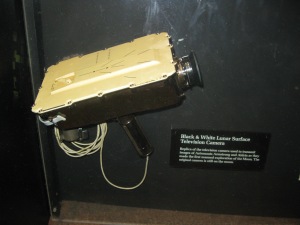
Here’s a replica of the black-and-white television camera that Armstrong and Aldrin used to show us their Apollo 11 moonwalk.
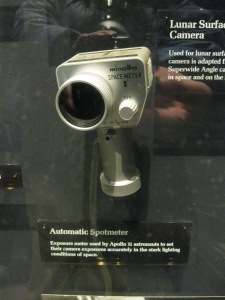
The Apollo 11 astronauts used a spotmeter to judge the exposures for their film camera. Looks as if Minolta made this for NASA.
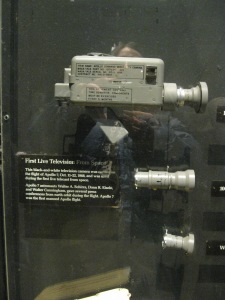
The Apollo 7 crew used this camera to make the first live telecast from space. This one’s the real McCoy.
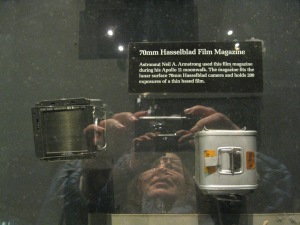
Armstrong’s Hasselblad film magazine from Apollo 11. He had to bring this back because it contained all the unexposed film.
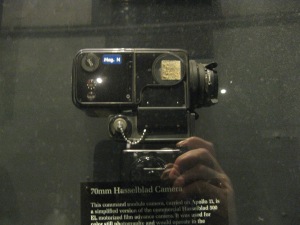
This camera flew in the Apollo 11 command module. And, yes, you can see the reflection of me and my digital camera.

The stereo camera that Apollo 11 astronauts used to get closeups of rocks without bending over. This is probably a replica, because I don’t see any moon dust on it.
Last year at this time, I was working on an article for Optics & Photonics News about the late Stanford University professor Anthony “Tony” Siegman and his legacy of laser education. I’m pleased that the second installment of the international laser school named for him will take place this August.
The Siegman International School on Lasers began last year on the Stanford campus, where its namesake taught for many years. This year it is moving to Germany, to keep with its stated purpose of being a truly international school for young optical scientists. I’m sure it will be held in yet another country in 2016.
The 2015 school has lots of interesting programming lined up for its 102 accepted students. I wish all the attendees well and hope that the event results in many fruitful collaborations.